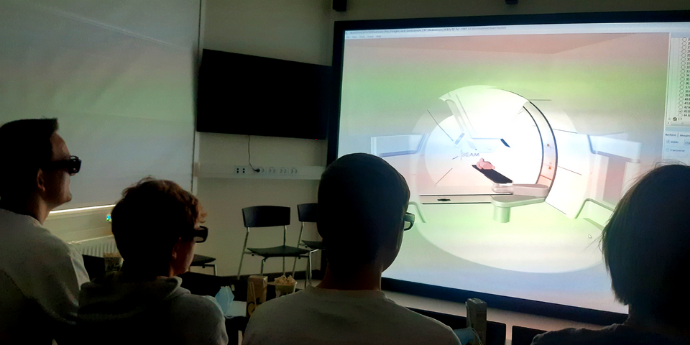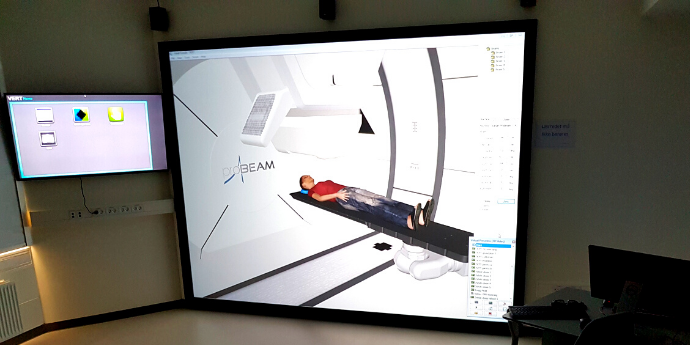Helping young patients and families understand proton therapy by 3D simulation

Seeing a 3D simulation of a proton therapy session can be a great learning experience for patients and families undergoing treatment. Photo: Simone Bertelsen, DCPT
22.06.2021
Originally developed for educational purposes and staff training, a 3D simulation solution has proved to be valuable in patient communication as well. A visit to the 3D cinema helps the youngest patients and their families visualise and understand proton therapy at the Danish Centre for Particle Therapy (DCPT).
A 3D cinema at Aarhus University Hospital has served a key purpose in the past couple of years, where proton therapy has been implemented in Denmark. Especially for children, adolescents and their families, 3D models and simulations helps to clarify the many aspects of treatment and what proton therapy entails in their specific situation.
- If possible and if the families wish so, we will schedule a visit in the cinema about one or two weeks after the first treatment, explains medical physicist Klaus Seiersen. - As we build experience with this format, the feedback from the families is highly positive, he says.
Medical physicists at DCPT will usually explain to the families in an overall manner how protons are generated in the cyclotron, and how the energy, movements and depth of the proton beam is accurately controlled. Most importantly, patients and their families get to experience a demonstration of how the patient's CT scan is used in treatment planning, how the patient is positioned on the treatment couch in the actual setting to receive the correct radiation dose, and how the treatment beams are directed towards the tumour from different directions.
Making each treatment step accessible
A young man named Jacob recently visited the 3D cinema. Even though this was on the final day of his treatment at DCPT, a visit to the cinema provided an understanding of how the treatment actually works.
- I had been asking if I could see or feel the beams, so it was a great experience to visualise my treatment, said 16-year-old Jacob, who brought his family along for the cinematic experience.
The family members noted that it helped them understand the radiation effect, and that it created a sense of security for the whole family, that staff members were transparent when explaining the treatment every step of the way. Not least, it made an impression starting from a small scanning image on a computer screen to seeing the images on a big screen in a highly precise 3D model of the actual body.
An example of what a 3D simulation of proton therapy looks like. Photo: Klaus Seiersen, DCPT
First proton centre in the world to use 3D solution
A couple of years back, there was no similar proton simulation solution on the market, although the software was already used for educational and research purposes within conventional radiotherapy. By request from and in collaboration with DCPT researchers and clinicians, the company Vertual Ltd. has developed the highly applicable 3D Proton VERT solution, that replicate the treatment rooms and equipment down to every single detail.
- Our goal has always been to help de-mystify the science and technology behind radiotherapy and make it understandable for patients and their families, explains Professor Andy Beavis, Chief Science Officer, Vertual Ltd.
- It is a pleasure to continue to be part of this very important work at the DCPT, says Mr James Ward, Chief Technical Officer, Vertual Ltd.
The medical physicists at DCPT use the same treatment plans and scans for the simulation as are used for the actual treatment. Klaus Seiersen was a part of the initial process and is a keen user of the 3D cinema today.
- We are very careful when explaining radiation effect and dose to the patients, and we make sure that they are not unpleasantly surprised by any of the images. Actually, we often experience the opposite; that it helps to reassure the families and that this is an opportunity for them to ask any unanswered questions they might have, Klaus Seiersen concludes.
Facts
- The 3D cinema is located at the oncology department of Aarhus University Hospital, right next to the Danish Centre for Particle Therapy. The cinema is mainly used for education and staff training e.g. in conventional radiotherapy with photons.
- The cinema is used as part of the national educational programme on radiation oncology, a course which is hosted at Aarhus University Hospital.
- Because of the complexity of the highly specialised treatment with proton therapy, the families of the youngest patients at DCPT are offered a run-through of their own treatment in the cinema. This is optional, and the family decides for themselves whether they wish to make use of this possibility.